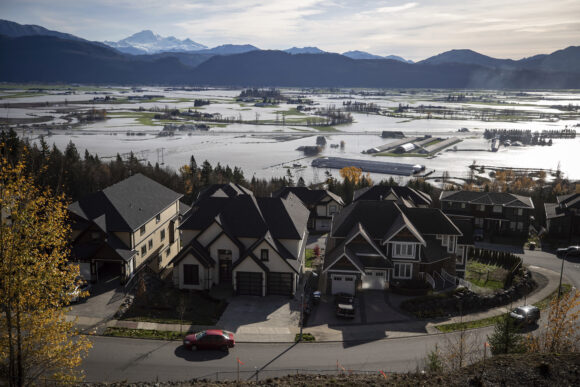Atmospheric rivers of the kind that drenched California and flooded British Columbia in recent weeks will become larger — and possibly more destructive — because of climate change, scientists said.
Columns in the atmosphere hundreds of miles long carry water vapor over oceans from the tropics to more temperate regions in amounts more than double the flow of the Amazon River, according to the American Meteorological Society.
These “rivers in the sky” are relatively common, with about 11 present on Earth at any time, according to NASA.
But warming air and seas around the globe causes conditions that scientists said will make them hold more moisture, causing extreme precipitation when they make landfall, often on the west coasts of North America, South America and Western Europe.
Because of climate change, atmospheric rivers are projected to become slightly less frequent, but more intense, according to a 2018 study https://agupubs.onlinelibrary.wiley.com/doi/10.1029/2017GL076968 led by researchers from NASA’s Jet Propulsion Laboratory.
“There may be fewer, but they are going to be lasting longer, and more intense,” Vicky Espinoza, an author of the NASA study who is now a graduate student at the University of California Merced, said.
Atmospheric rivers will become about 10% less frequent by the end of this century, but about 25% longer and wider, the study found. That will lead to nearly double the frequency of the most intense atmospheric river storms.
Weak atmospheric river systems provide rain and snow that are needed for freshwater supplies. Stronger storms, however, can lead to flooding and extreme winds that disrupt travel, cause mudslides and damage property.
One such event in Canada this month dumped a month’s worth of rain in two days, prompting fatal floods and landslides in British Columbia, devastating communities and severing access to the country’s largest port.
They are not always catastrophic. One such storm last month in drought-stricken California triggered mudslides, toppled utility poles and blocked roadways, but also helped replenish depleted reservoirs and reduced the risk of wildfires by saturating the state’s parched vegetation.
“Because everything was so dry in California, there were a lot of benefits to that storm,” said Julie Kalansky, deputy director for operations at the Center for Western Weather and Water Extremes at the Scripps Institution of Oceanography.
The atmospheric river that hit California last month was accompanied by a so-called “bomb cyclone,” a weather hazard that holds more precipitation and produces stronger winds.
“It’s like the river supercharges the cyclone’s engine,” said Carl Schreck, a researcher with North Carolina State University’s Cooperative Institute for Satellite Earth System Studies.
But as the events in Canada have shown, when heavy precipitation falls on fire-ravaged areas the results can be devastating.
Wildfires, like the ones that hit British Columbia this summer, destroy tree canopies that catch rain and roots that suck up moisture and cling to soil. The fires leave a thick layer of water-repellent ash along forest floors.
“Not only are we having more of these so-called atmospheric rivers, but we also have the added secondary effect of heat and drought… which then amplify the effects of heavy rainstorms,” said Matthias Jakob, a geoscientist with Canada’s BCG Engineering.
About the photo: Flooded farmland is seen in the valley below houses in Abbotsford, British Columbia., on Wednesday, Nov. 17, 2021. (Darryl Dyck/The Canadian Press via AP)
Was this article valuable?
Here are more articles you may enjoy.


 Tricolor Trustee Plans to Sue Founder for Auto Dealer’s Collapse
Tricolor Trustee Plans to Sue Founder for Auto Dealer’s Collapse  ‘Dream Is in Sight:’ Chamber, Reinsurers, Insurers Urge Florida to Stay the Course
‘Dream Is in Sight:’ Chamber, Reinsurers, Insurers Urge Florida to Stay the Course  Truckers Who Fail English Tests Get Pulled Off Roads in Trump Crackdown
Truckers Who Fail English Tests Get Pulled Off Roads in Trump Crackdown  OpenAI And Microsoft Sued Over Murder-Suicide Blamed on ChatGPT
OpenAI And Microsoft Sued Over Murder-Suicide Blamed on ChatGPT 